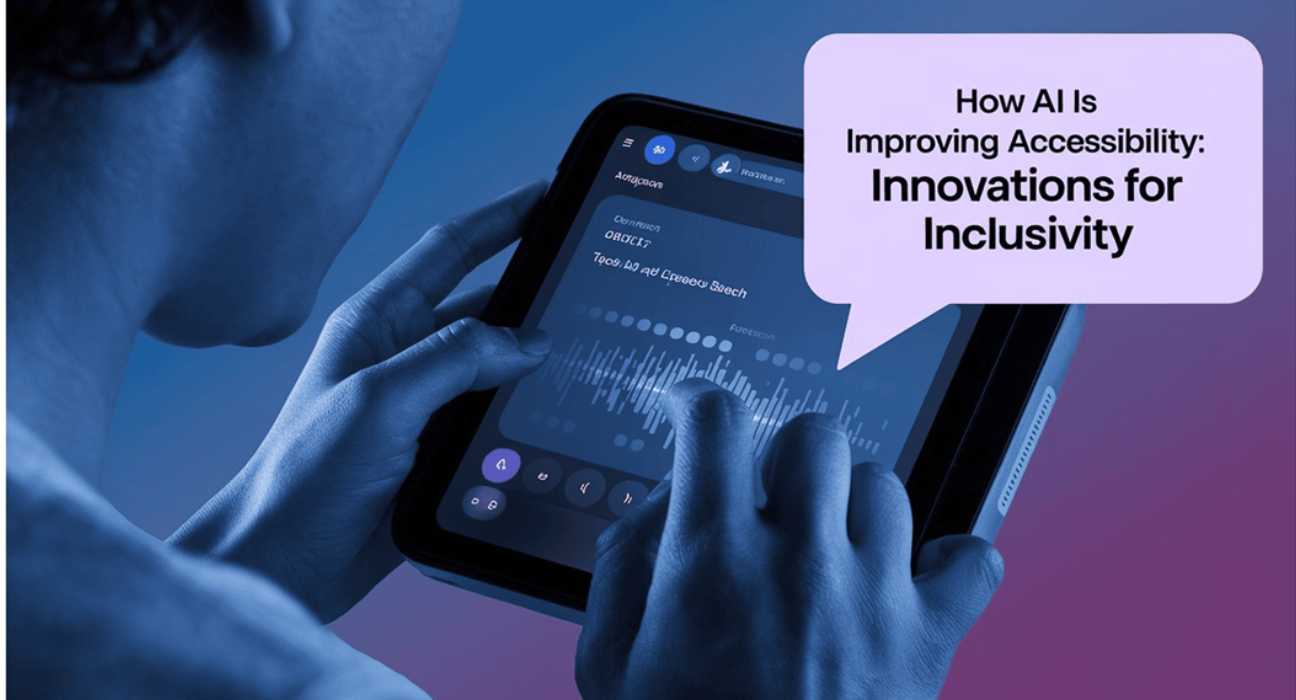Artificial Intelligence is going to make the future of inclusivity a reality as it transforms millions of people around the globe. It has so far made real-time communication possible to and for deaf persons, helped the visually impaired to navigate their surroundings, and much more. AI is making an association where technology and human limitations join hands. This article introduces how AI has been remaking access and sheds light on a few key innovations and what they do for people with disabilities.
The Role of AI in Accessibility
Accessibility refers to the creation of equal opportunity access to services and technology for all, regardless of disability. Most of the traditional methods have left their gaps in usability, but AI has made a massive leap forward in addressing those issues. With machine learning-based computer vision and natural language processing, the AI-based accessibility tools are now recognizing and catering to such needs that were unimaginable a few years ago.
AI Assistive Technology: A Life
AI assistive technology is the lifeline to disabled people. Whether speech-to-text applications, where its users talk and communicate without a glitch, or smart navigation systems, which allow visually challenged people to navigate totally unknown places, AI is unlocking all roads leading to independence.
Some of the critical categories of AI assistive technologies are:
- AI for Speech Impairments: Voice-enabled communication systems.
- AI for Mobility: Smart wheelchairs and AI-driven prosthetics.
- AI For Sensory Disabilities: Devices for visual and auditory impairments.
AI for Disabilities: What’s Next?
AI for disabilities has grown from having software alone to one bearing hardware and real-time solutions. Let us drill a little more into how AI improves accessibility with different types of impairments.
- AI Solutions for the Hearing Impaired
Innovations driven by artificial intelligence are changing the way deaf people interact with their environments: real time speech-to-text transcription, sign recognition, and enhanced hearing aids.
- Google Live Transcribe (Free): Using Google’s AI-based speech recognition, this is an app which provides real time transcription of conversations-thus much easier for a deaf or hard-of-hearing individual to have a two-way conversation with another.
- Otter.ai ($8.33/month): Otter provides real-time transcription of work meetings, lectures, and personal conversations, from spoken words written down in real-time.
- AI for the Blind
AI is changing day-to-day life for the blind through applications that use machine learning interpretations of the environment that describe it.
- Microsoft Seeing AI (Free): That is an absolute example of AI accessibility since, using computer vision, it can describe objects, read texts, and even identify faces. It describes surroundings so the visually impaired person can have even more independence over their daily activities.
- Be My Eyes (Free): They connect a visually impaired user with a volunteer for help via video call so that the person can either describe their environment or seek help with daily tasks.
- Artificial Intelligence for Motor Impairments
For the first time ever, AI is transforming prosthetics, home automation, and robotics for the mobility-impaired.
- Liftware ($195): Using its AI, this utensil steadies hand motions for people with shaking, making it possible for them to feed themselves. It’s the perfect example of machine learning use in accessibility-to a point where it can learn and adapt to the needs of just one individual.
- BrainGate (in development): A neural interface system enabling even those unable to convey their wishes via speech to control an output device, say a robot limb, by brain activity interpreted by AI algorithms.
- Cognitive Disabilities
AI tools for all those cognitive disabilities on the spectrum are salvaging individuals who suffer from autism, ADHD, and learning disability in their relationship between technology and education activities.
- LAMP Words for Life ($299): This is a communication application using AAC by which children with autism or some sort of speech disorder can speak better.
- Cognoa (Free Trial): These are apps that offer early detection, diagnosis, and treatment for autism. Cognoa uses machine learning to interpret behavior and offers personalized treatment options.
AI Accessibility Tools in Education
One of the biggest benefactors of AI accessibility, however, is education. The computer sciences behind AI have been used in schools and universities to facilitate the ability of students with special needs to sidestep some of the challenges they would face if they learned the traditional way.
- Speech Recognition for Learning Disabilities: AI utilities like Dragon NaturallySpeaking ($150) allow a student suffering from physical disability or dyslexia to deliver essays, emails, or assignments through dictation. It therefore does away with note-taking by hand, leading to more efficiency.
- Screen Readers and Text-to-Speech: Screen readers for students with visual impairments include JAWS ($90/year), which provides text-to-speech as well as easier means of accessing digital material, and Kurzweil 3000. AI-driven tools convert written text to spoken words, hence making the learning process considerably fluent.
AI for Inclusive Tech at Work
Accessibility at work is also one of the resultant sectors impacted by AI-advancing tools. Indeed, many companies adopt technologies that address persons with disabilities at work.
- Live Captioning and Communication Tools
Video conferencing tools like Zoom (Free) and Microsoft Teams ($4/month and up) now include AI-powered captioning capabilities with meeting features. Employees with hearing disabilities are able to fully participate in discussions without any setbacks.
- AI-Powered Hiring Tools
AI is enabling the hiring process to be inclusive. Applications such as HireVue (Price upon request) make use of an AI algorithm to analyze applicants based on their skills and not any form of physical ability, thus helping minimize discrimination and encouraging diversity.
- AI for Productivity
Writing tools such as Grammarly (Free and paid plans) make grammar and style suggestions. For people with mental impairments, the type of communication has improved, and they are more efficient in their workplaces.
AI-Based Solutions for the Hearing Impaired: A Deep Dive
AI has definitely enhanced the aspects of personal communication that increase the inclusivity of working spaces, classroom environments, and public environments, by breaking the barriers to communication.
- Real-Time Captioning AVA ($16/month): This is an amazing solution; with it, conversations, lectures, and group discussions get transcribed in real-time, and those with a hearing impairment can follow along in real time.
- AI-Enhanced Hearing Aids: Oticon Opn S is one sophisticated hearing aid that uses AI to sense a noisy environment and filters out background noise. The technology renders a more natural listening experience, which leads to better quality of life for the users.
Machine Learning for Accessibility: A Glimpse into the Future
As machine learning improves, it is a part of accessibility applications that has to expand as well. Technology for inclusive AI has already changed several industries, but future developments look even more impressive.
- AI for Real-Time Sign Language Translation
Other scientists strive at developing equipment for the translation of sign language in real time. This technology would enable those who cannot hear, particularly the deaf, and lack knowledge of how to manipulate sign language to easily interact with each other, thereby creating a more accessible environment.
- AI-Powered Smart Homes
Voice-activated assistants like Amazon Alexa ($99.99) and Google Assistant (Free) have already been capable of enabling people with disabilities to control all sorts of devices in smart homes via voice control. With such tools, users find them more intuitive and personalized, thus further enhancing accessibility in this regard.
Challenges and Ethical Concerns
Above the numerous promises of AI accessibility tools, there are several challenges and concerns that come with them.
- Bias in AI Algorithms
Sometimes, bias creeps into AI systems, unwittingly excluding some disabilities. As mainstream AI may unintentionally exclude certain groups of people, it is imperative to make the AI tools accessible.
- Accessibility
Most AI accessibility applications are free and very cheap. The more advanced devices, like prosthetics or AI assisted, are pricey and very unaffordable. Therefore, the accessibility of future innovations should be within the reach of even more users.
- Data Privacy
Many AI tools collect vast amounts of data to facilitate personalized service, which raises concerns over privacy. It is through finding a balance between personalization and security that public trust will come back into AI technologies.
Conclusion: AI Accessibility for a More Inclusive World
AI accessibility technologies may really revolutionize the way a person with a disability will be able to live in this world. From hearing aids that adjust to background noise to voice assistants that control homes, that brings independence and quality of life enhancing factors. But to unlock AI’s full potential at really creating a more accessible future, it requires a continuous investment in affordability, inclusivity, and moral development.
An integration of AI-powered accessibility solutions is one such step towards a future that is by design inclusive, enabling all humanity to have equal opportunities.
In this respect, the future AI accessibility advances promises: It will be more inclusive and diverse; it will be able to be more technologically and socially advanced, offering opportunities for all to engage fully with the world around them.

